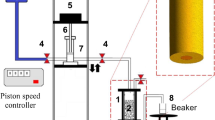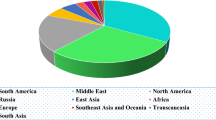Abstract
The primary motivation of this work was the enhanced oil recovery in porous media. Polymeric solutions are largely used in tertiary oil recovery and it is of great interest to understand the role played by their properties in the recovery process. It is largely accepted that these solutions can increase the recovery efficiency compared to the water-flooding operation, but some doubts still remain. When polymers are added to a solvent, the viscosity of the mixing increases, and the solution becomes non-Newtonian, exhibiting shear-thinning behaviour and viscoelasticity. Thus, conducting tests that isolate all important parameters is not easy, and this is the goal here. A compact sand porous media was used, which was previously saturated with oil-based solutions. Such oil was recovered by the injection of Newtonian water-based or viscoelastic solutions. Diluted polyethylene oxide solutions, with concentration much lower than ten times the overlap concentration, were used. Below such concentration, elastic turbulence is not observed, and the so-called Saffman–Taylor problem is the main point here. The primary data are the fraction of unrecovered mass m until the displacing fluid breakthrough. The lost mass m was recorded as a function of the capillary number Ca, viscosity ratio \(R_{\mu }\), and Weissenberg number Wi. It was shown that for the cases evaluated in this work, the capillary effects were negligible, and therefore, \(R_{\mu }\) and Wi were the only parameters that control the flow behaviour. For the Newtonian scenario, the not recovered mass m felt from 77.5%, for \(R_{\mu } = 41.82\), to 20%, for \(R_{\mu } = 0.52\), leading to an increase in the recovery ratio of 57.5%. For a fixed viscosity ratio, m felt with Wi until reaching an asymptotic value. For \(R_{\mu } = 1\), the increase of Wi from \(Wi = 0.49\) to \(Wi\ge 5\) leads to an increase in the recovery ratio of 35%, showing that more elastic fluids can improve the efficiency of the process.













Similar content being viewed by others
References
Tunio SQ, Tunio AH, Ghirano NA, Adawy ZME (2011) Comparison of different enhanced oil recovery techniques for better oil productivity. Int J Appl Sci Technol 1(5):143–153
Needham RB, Doe PH (1987) Polymer flooding review. J Pet Tech 39:1503–1507
Bretherton FP (1961) The motion of long bubbles in tubes. J Fluid Mech 10:166–188
Taylor GI (1961) Deposition of a viscous fluid on the wall of a tube. J Fluid Mech 10:161–165
Cox BG (1962) On driving a viscous fluid out of a tube. J Fluid Mech 14:81–96
Chen J-D (1986) Measuring the film thickness surrounding a bubble inside a capillary. J Colloid Interface Sci 109(2):341–349
Westborg H, Hassager O (1989) Creeping motion of long bubbles and drops in capillary tubes. J Colloid Interface Sci 133(1):135–147
Chebbi R (2003) Deformation of advancing gas-liquid interfaces in capillary tubes. J Colloid Interface Sci 265(1):166–173
Soares EJ, Carvalho MS, de Souza Mendes PR (2005) Immiscible liquid-liquid displacement in capillary tubes. J Fluids Eng 127(1):24–31
Sousa DA, Soares EJ, Queiroz RS, Thompson RL (2007) Numerical investigation on gas-displacement of a shear-thinning liquid and a visco-plastic material in capillary tubes. J Non-Newton Fluid Mech 144:149–159
Feng JQ (2009) Along gas bubble moving in a tube with flowing liquid. Int J Multi-phase Flow 35:738–746
Soares EJ, Thompson RL (2009) Flow regimes for the immiscible liquid-liquid displacement in capillary tubes with complete wetting of the displaced liquid. J Fluid Mech 641:63–84
Lac E, Sherwood JD (2009) Motion of a drop along the centerline of a capillary in a pressure-driven flow. J Fluid Mech 640:27–54
Freitas JF, Soares EJ, Thompson RL (2011) Residual mass and flow regimes for the immiscible liquid-liquid displacement in a plane channel. Int J Multiph Flow 37:640–646
Thompson RL, Soares EJ (2012) Motion of a power-law long drop in a capillary tube filled by a newtonian fluid. Chem Eng Sci 72:126–141
Soares EJ, Thompson RL, Niero DC (2015) Immiscible liquid-liquid pressure-driven flow in capillary tubes: experimental results and numerical comparison. Phys Fluids 27:082105
Allouche M, Frigaard IA, Sona G (2000) Static wall layers in the displacement of two visco-plastic fluids in a plane channel. J Fluid Mech 424:243–277
Soares EJ, Souza Mendes PR, Carvalho MS (2001) Gas displacement of non-newtonian fluids in a tube. In: of Mechanical engineers, A.S. (ed.) International Mechanical Engineering Conference and Exposition
Frigaard IA, Bittleston SH, Ferguson J (2002) Mud removal and cement placement during primary cementing of an oil well. SPE, Houston
Dimakopoulos Y, Tsamopoulos J (2004) On the gas-penetration in straight tubes completely filled with a viscoelastic fluid. J Non-Newton Fluid Mech 117(2):117–139
Dimakopoulos Y, Tsamopoulos J (2004) On the gas-penetration in straight tubes completely filled with a viscoelastic fluid. J Non-Newton Fluid Mech 117(2–3):117–139
Huzyak PC, Koelling KW (1997) The penetration of a long bubble through a viscoelastic fluid in a tube. J Non-Newton Fluid Mech 71:73–88
Kamisli F, Ryan ME (1999) Perturbation method in gas-assisted power-law fluid displacement in a circular tube and retangular channel. Chem Eng J 75:167–176
Lee AG, Shaqfeh ESG, Khomami B (2002) A study of viscoelastic free surface flows by the finite element method: Hele-shaw and slot coating flows. J Non-Newton Fluid Mech 108:327–362
Soares EJ, Carvalho MS, de Souza Mendes PR (2006) Gas-displacement of non-newtonian liquids in capillary tubes. Int J Heat Fluid Flow 27(1):95–104
Thompson RL, Soares EJ, Bacchi RDA (2010) Further remarks on numerical investigation on gas-displacement of a shear-thinning liquid and a visco-plastic material in capillary tubes. J Non-Newton Fluid Mech 165:448–452
Freitas AA, Soares EJ, Thompson RL (2011) Immiscible Newtonian displacement by a viscoplastic material in a capillary plate channel. Rheol Acta 50:403–422
Taghavi SM, Alba K, Moyers-Gonzalez M, Frigaard I (2012) Incomplete fluid-fluid displacement of yield stress fluids in near-horizontal pipes: experiments and theory. J Non-Newton Fluid Mech 167:59–74
Alba K, Taghavi SM, Bruyn JR, Frigaard I (2013) Incomplete fluid-fluid displacement of yield-stress fluids. part 2: highly inclined pipes. J Non-Newton Fluid Mech 201:80–93
Freitas JF, Soares EJ, Thopson RL (2013) Viscoplastic-viscoplastic displacement in a plane channel with interfacial tension effects. Chem Eng Sci 91:54–64
Caliman HM, Soares EJ, Thompson RL (2017) An experimental investigation on the Newtonian-Newtonian and viscoplastic-Newtonian displacement in a capillary tube. J Non-Newton Fluid Mech 247:207–220
Goldsmith HL, Mason SG (1963) The flow of suspensions through tubes. J Colloid Sci 18:237–261
Soares EJ, Carvalho MS, de Souza Mendes PR (2008) Immiscible liquid-liquid displacement in capillary tubes: viscoelastic effects. J Braz Soc Mech Sci Eng 27:160–165
Shende T, Niasar V, Babaei M (2021) Pore-scale simulation of viscous instability for non-newtonian two-phase flow in porous media. J Non-Newton Fluid Mech 296:104628
Meter DM, Bird RB (1964) Tube flow of non-newtonian polymer solutions: Part i. laminar flow and rheological models. AICHE J 10(6):878–881
Zhong H, Li Y, Zhang W, Yin H, Lu J, Guo D (2018) Microflow mechanism of oil displacement by viscoelastic hydrophobically associating water-soluble polymers in enhanced oil recovery. Polymer 10(6):628
Nilsson MA, Kulkarni R, Gerberich L, Hammond R, Singh R, Baumhoff E, Rothstein JP (2013) Effect of fluid rheology on enhanced oil recovery in a microfluidic sandstone device. J Non-Newton Fluid Mech 202:112–119
de Castro AR, Oostrom M, Shokri N (2016) Effects of shear-thinning fluids on residual oil formation in microfluidic pore networks. J Colloid Interface Sci 472:34–43
Lotfollahi M, Koh H, Li Z, Delshad M, Pope GA (2016) Mechanistic simulation of residual oil saturation in viscoelastic polymer floods. In: SPE EOR Conference at oil and gas West Asia
Groisman A, Steinberg V (2004) Elastic turbulence in curvilinear flows of polymer solutions. New J Phys 6(1):29
Howe AM, Clarke A, Giernalczyk D (2015) Flow of concentrated viscoelastic polymer solutions in porous media: effect of mw and concentration on elastic turbulence onset in various geometries. Soft Matter 11:6419–6431
Clarke A, Howe AM, Mitchell J, Staniland J, Hawkes L, Leeper K (2015) Mechanism of anomalously increased oil displacement with aqueous viscoelastic polymer solutions. Soft Matter 11:3536–3541
Clarke A, Howe AM, Mitchell J, Staniland J, Hawkes LA (2016) How viscoelastic-polymer flooding enhances displacement efficiency. SPE J 21(03):0675–0687
McKinley GH, Pakdel P, Oztekin A (1996) Rheological and geometric scaling of purely elastic flow instabilities. J Non-Newton Fluid Mech 67:19–47
Lambe TW, Whitman RV (1969) Soil mechanics, 1st edn. Wiley, New York
Oliveira CF, Pires PJM, Teixeira JESL (2021) Physical, mechanical, and microstructure investigation of tropical clayey soils stabilised with desulfurisation slag for pavement application. Road Mater Pavement Des 22(06):1442–1453
Sankaran AK, Dros DA, Meerman HJ, Picken SJ, Kreutzer MT (2013) Increasing the stability of high contraction ratio flow of boger fluids by pre-deformation. J Non-Newton Fluid Mech 196:27–35
Drost S, Westerweel J (2014) Interaction effects in multi-outlet viscoelastic contraction flow. J Non-Newton Fluid Mech 213:31–38
Martins I, Soares EJ, Siqueira RN (2022) Mechanical scission of a flexible polymer (polyethylene oxide) under highly turbulent flows through abrupt contractions. J Non-Newton Fluid Mech 301:104740
Schramm G (2000) A practical approach to rheology and rheometry, 2nd edn. Thermo Haake, Gebrueder HAAKE GmdH, Karlsruhe,
Trussel RR, Chang M (1999) Review of flow through porous media as applied to head loss in water filters. J Environ Eng 125:998–1006
Lenormand R, Touboul E, Zarcone C (1988) Numerical models and experiments on immiscible displacements in porous media. J Fluid Mech 189:165–187
Dias MM, Payatakes AC (1986) Network models for two-phase flow in porous media part 1. immiscible microdisplacement of non-wetting fluids. J Fluid Mech 164:305–336
Hu Y, Patmonoaji A, Zhang C, Suekane T (2020) Experimental study on the displacement patterns and the phase diagram of immiscible fluid displacement in three-dimensional porous media. Adv Water Resour 140:103584
Zhang C, Oostrom M, Wietsma TW, Grate JW, Warner MG (2011) Influence of viscous and capillary forces on immiscible fluid displacement: pore-scale experimental study in a water-wet micromodel demonstrating viscous and capillary fingering. Energy Fuels 25(8):3493
Author information
Authors and Affiliations
Corresponding author
Additional information
Technical Editor by Roney Leon Thompson.
Publisher's Note
Springer Nature remains neutral with regard to jurisdictional claims in published maps and institutional affiliations.
Rights and permissions
Springer Nature or its licensor (e.g. a society or other partner) holds exclusive rights to this article under a publishing agreement with the author(s) or other rightsholder(s); author self-archiving of the accepted manuscript version of this article is solely governed by the terms of such publishing agreement and applicable law.
About this article
Cite this article
Oliveira, F.D., Siqueira, R.N., Pires, P.J.M. et al. Viscous liquid recovery by injection of Newtonian and viscoelastic materials in a sand porous media. J Braz. Soc. Mech. Sci. Eng. 45, 449 (2023). https://doi.org/10.1007/s40430-023-04345-0
Received:
Accepted:
Published:
DOI: https://doi.org/10.1007/s40430-023-04345-0




